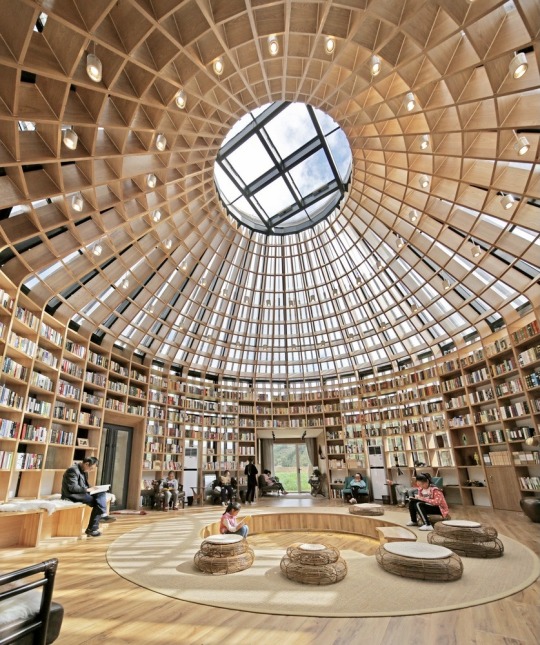#Weichang
Text
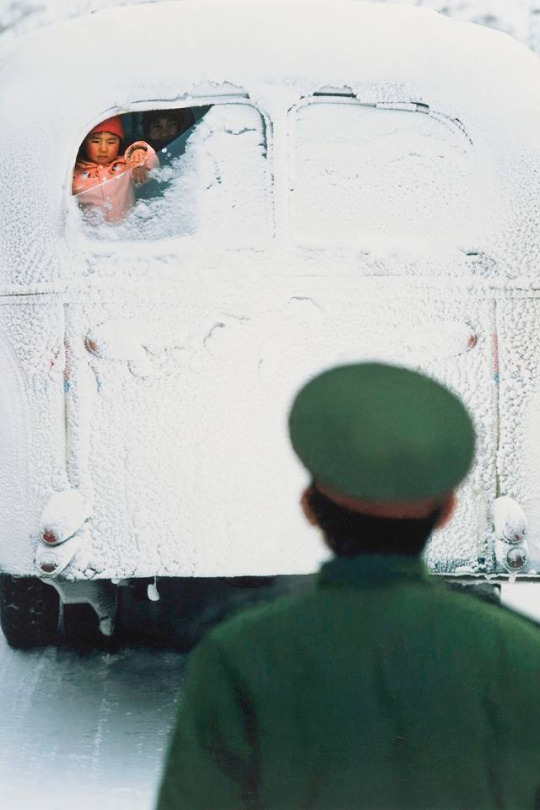
A soldier bids farewell to his wife and child who have just visited him and are now returning home. Weichang, Hebei, China. Winter 1987
Photo: Feng Jianxin
36 notes
·
View notes
Text
An Ding Peak Uniform Design
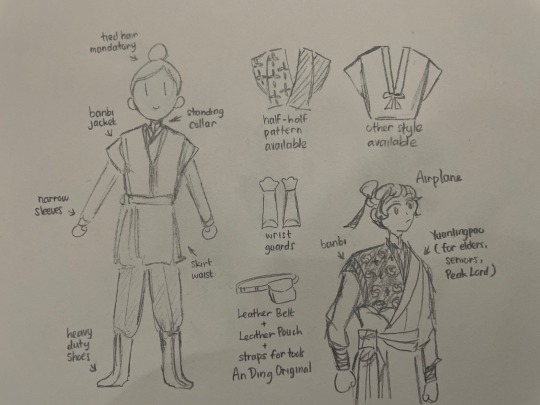
- Rather than focusing on time periods it’s easier to use a single article as vocal point. An Ding’s is banbi (half sleeve jacket). Also known as half-beizi and dahu. There are varieties, mostly collars, ties and buttons. I’m going to go with blue for the color.
- While one can use wrist guard to secure otherwise large/hanging sleeves, An Ding stick to narrow sleeves so its easier to roll up and less likely to drag. Clothing that trail on the ground or fiddly bits are big no nos! That’s a recipe for hazard.
- Full disclosure, I have no idea what the skirt waist is called. Other term is skirt belt. I was this close to call it apron. I’ve seen both men and women wear this as part of their hanfu ensemble. Research led me to mofu (skirt that can be tied around waist or chest), weichang and zhaojia. What I have in mind is not exactly those, but I hit a dead end. Both pants and skirt belt have pockets. Since it resembles apron it give them the servant feel lol.

Official SVSSS arts have the ladies wear short skirts? Which is not exactly accurate as far as Ancient Chinese fashion goes, but on par with Stallion novel. In any case, the female population of An Ding have their cleavage and legs covered. Also hairstyles that make them resemble rodents in honor of Rat Man Shang Qinghua lmao
94 notes
·
View notes
Note
I’m not sure if you’ve covered it or not, but what style dress does Yue wear when she becomes the Moon Spirit? I love the style and think it looks so pretty
Yue’s dress is mostly fantastical, with some Chinese touches.
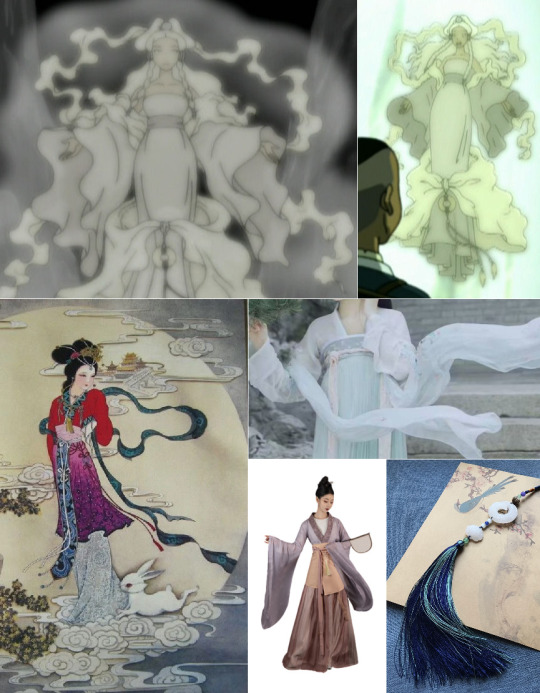
The thin scarf wrapped around her arms is called a pibo (披帛). The little floaty fabric with the jade pendant hanging from it looks like a detached weichang (围裳) with a jinbu (禁步). Weichang are overskirts meant to be layered over dresses and jinbu are dangling decorations meant to hang over skirts to prevent them from flying up. Since Yue’s a spirit, her weichang seems to just levitate around her gown ethereally. These accessories are often featured in depictions of the Chinese moon goddess, Chang’e (嫦娥). Other aspects of Yue’s design are also inspired by Chang’e.
Other than that, the dress is more just vaguely anime-inspired. The detached sleeves are especially common in anime.
If you want something with a similar ethereal feel to Yue’s outfit, but with more basis in a real-world culture, you could look into white-colored hanfu. 8)
489 notes
·
View notes
Text
Hanfu Accessories 👑
Accessories
Miansha/Mianlian (face veil)
Yingluo
Xiangquan
Maoling
Doupeng (cloak)
Qiuyi
Pibo (shawl)
Panbo (string to tie the sleeves back)
Youzhisan (oil paper umbrella)
~~
Sleeves
Water Sleeves
Huwan (arm guards)
Bangshoudai (hand wraps)
Yexiu
Pipaxiu (pipa-shaped sleeves)
~~
Waist Accessories
Weichang
Weifu
Zaju
~~
Yaopei (Waist Ornaments)
Jinbu
Hebao
~~
Fans
Tuanshan (stiff round fan)
Bianmian (stiff semi-circle fan)
Zheshan (folding fan)
Yaoshan
~~
Hats
Mili
Weimao (veiled hat)
Humao
Douli
Tiger Hat
Futou
~~
Hair Accessories
Guan (crown)
Xiaoguan (topknot crown)
Lianhua Guan (lotus crown for taoist priests)
Furongguan (lotus crown for women)
Mianguan (emperor’s headdress/crown)
Zanhua
Chanhua
Ronghua
Juanhua
~~
2 notes
·
View notes
Text
Huaxianxu Announced as 10th International University Fashion Design Gala Spokesperson
<h3>Huaxianxu Announced as Spokesperson for 10th International University Fashion Design Gala</h3>
<p>A news conference for the 10th International University Fashion Design Gala was recently held in Beijing. According to Professor Liu Yuanyuan, the chief planner of the gala, this year's theme is "Source · Creation", with the meaning of tracing origins and sticking to one's roots, to open up an even brighter future with youthful vigor and dreams.</p>
<p>On scene, Hu Xianxu, one of the "Four Little Buddhas" of the new generation, was officially announced as the spokesperson for this gala. Xianxu, who has unique ideas about styling and dressing up on his own, also expressed his understanding of fashion: "Fashion is the externalization of inner cultivation."</p>
<p>On the same day, Dr. Yang Weichang, chairman of the Federation of International Universities in Northern China, presented Hu Xianxu with an appointment certificate. He also indicated striving to build a broad platform for professional fashion design talent development for youth at home and abroad.</p>
<p>Expert guests from the fashion industry were also invited on the day to discuss topics on cultivating fashion talents. It is understood that the award ceremony for the 10th International University Fashion Design Gala will be held on May 25th, at which time the most fashion-impacting winning works will be unveiled.</p>
0 notes
Photo

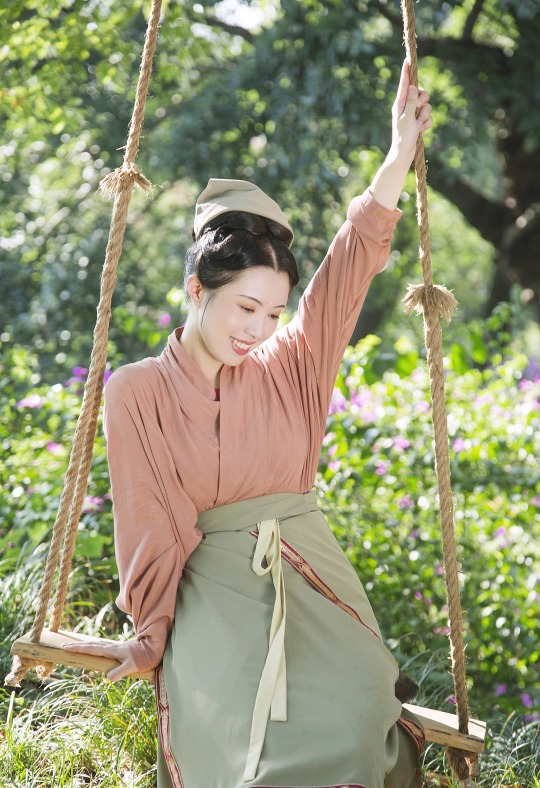

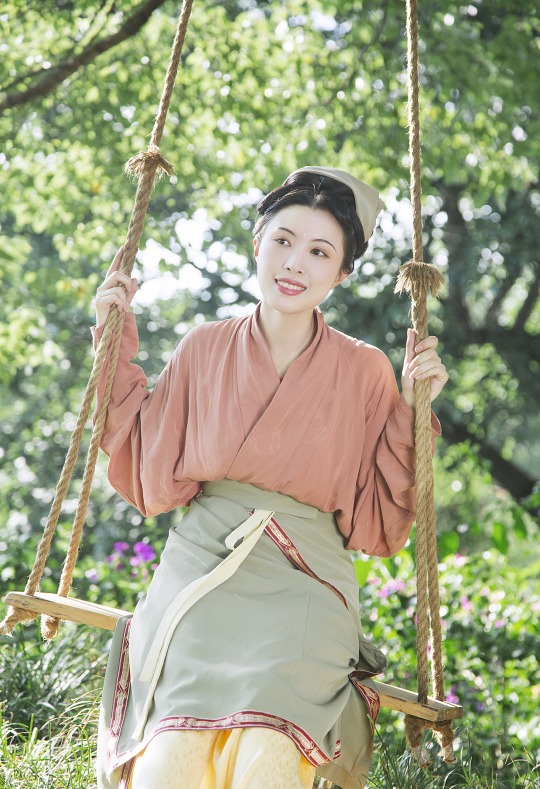
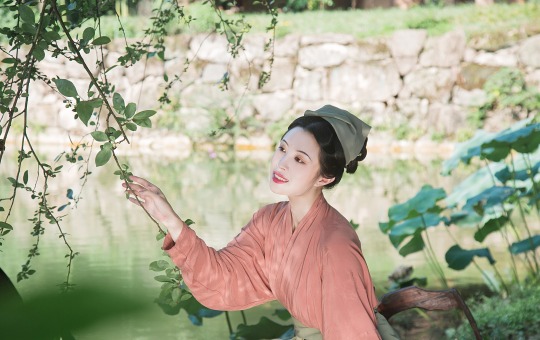
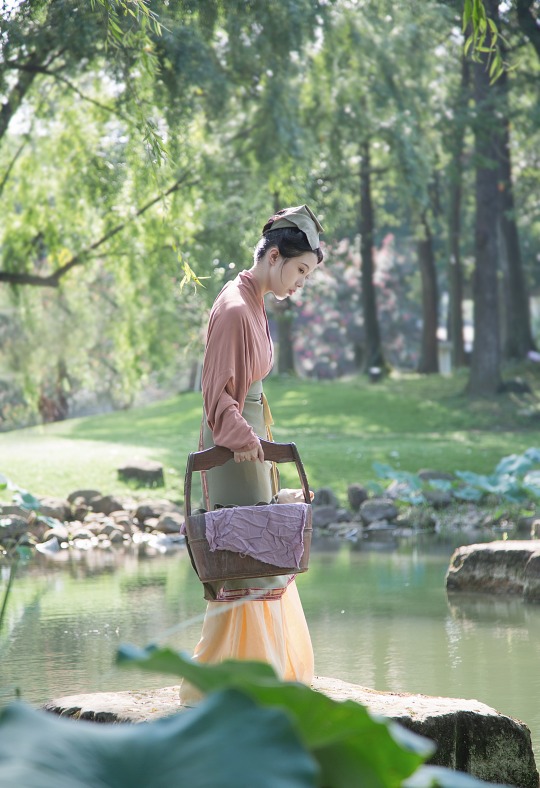

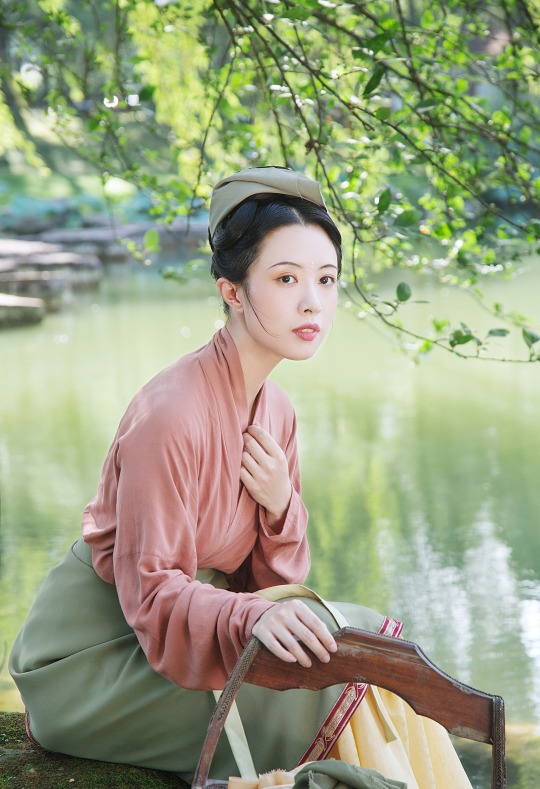


Qiyao Ruqun hanfu by 花下有期汉服工作室
Model: 绝汩之九川
#Hanfu#Ruqun#Weichang#Qiyao Ruqun#Chinese Fashion#Chinese Inspired#Chinese Mode#Ancient China#Photography
514 notes
·
View notes
Note
Are you watching The Rise of the Phoenixes on Netflix? If so what’s your fav outfit so far?
Hi, thanks for the question!
I’m going to combine this question with another one I received that mysteriously disappeared (tumblr must’ve eaten it…), which asked to identify the clothing in “The Rise of Pheonixes”. Disclaimer that I haven’t watched the actual show, so everything here is going to be based off of photos.
Similar to “The Empress of China”, the costumes in “The Rise of Phoenixes” are mostly based on Tang dynasty hanfu, with some creative liberties taken by the designers. Female lead Feng Zhiwei’s most commonly worn female outfit is the chest-high ruqun, an outfit consisting of a top (ru) and skirt (qun), in which the skirt is tied above the breasts or at the bust point. It’s often accessorized with a large-sleeve outer robe called daxiushan.
Feng Zhiwei seems to be fond of wearing sheer ru & matching qun and daxiushan cut from the same cloth:

Sometimes she’ll wear a short outer skirt called weichang over the qun (in the outfit below, the weichang and daxiushan are matching):
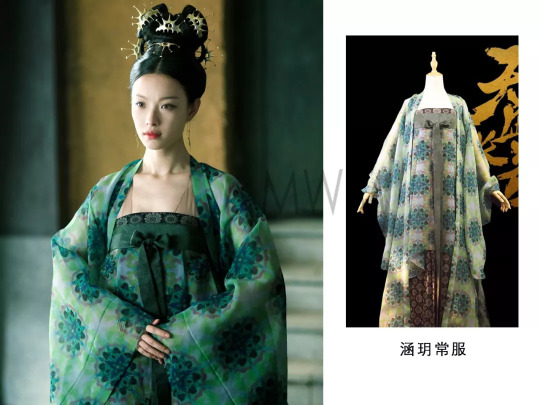
This outfit comprises a non-sheer purple ru & dark blue polka-dotted weichang, as well as a light purple beizi (jacket):
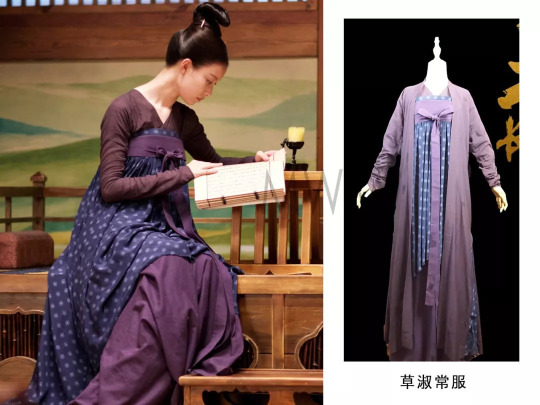
Ruqun is often accessorized with a long scarf called pibo, that’s worn wrapped around the arms & behind the back, as can be seen in the photo on the left:

Another style of women’s hanfu on the show is heziqun, an outfit that consists of the hezi (strapless chest cover), skirt (qun), and top (ru). The hezi is worn over the top, and a thin cloth belt is typically used to hide the joint between the hezi and skirt. Heziqun is also accessorized with daxiushan and pibo:


Feng Zhiwei also wears parallel-collar waist-high ruqun:

…and what appears to be a zhiju (straight-hem robe):
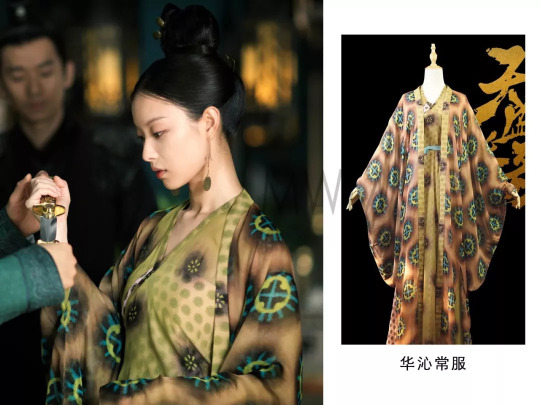
The male costumes worn on the show are mainly based on Tang, Song, and Ming dynasty fashions, and mostly comprise a variety of round-collar clothing based on the hanfu styles of yuanlingpao, yuanlingshan, and lanshan.Feng Zhiwei’s most common male outfit is the yuanlingpao (round-collar robe):


Here are some of the various round-collar outfits worn by the men on the show, including male lead Ning Yi:



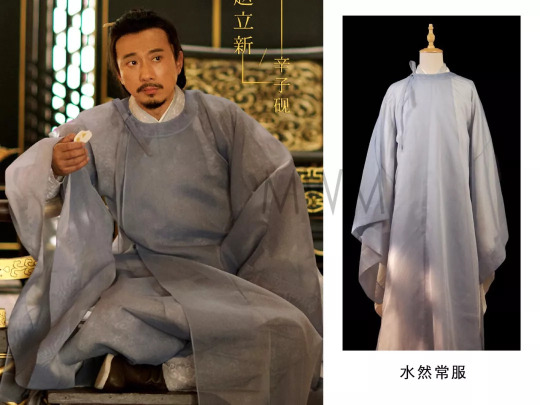
Here’s Ning Yi in mianfu, the ceremonial hanfu of the Emperor:
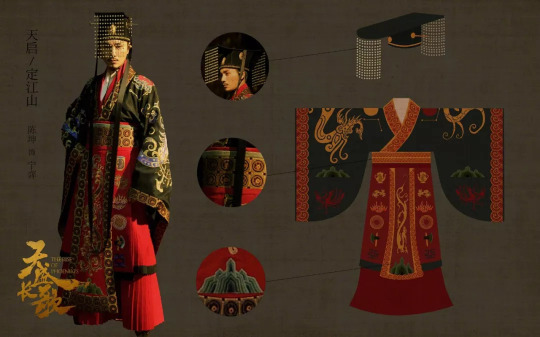
As for the question of what my favorite outfit is - personally, from looking at the photos, I find the male costumes more captivating than the female ones. Still, if I had to choose a favorite outfit worn by Feng Zhiwei, it’d be this ruqun below (the outfit also appears in this gifset). I love the sheer ru and the earthy color scheme:

For favorite male outfits, I really like the dark brown yuanlingpao worn by Ning Yi in this shot. It goes really well with his long black hair and blue tuanshan (fan):

Finally, of course we can’t forget assassin/bodyguard Gu Nanyi’s Wuxia-inspired outfits - they make him look especially stunning!:


Hope this helps!
Photos via: 1, 2
#hanfu#the rise of phoenixes#mens hanfu#drama costumes#drama#ruqun#daxiushan#pibo#weichang#beizi#heziqun#zhiju#yuanlingpao#wuxia#braceface42#ask#reply#>1000
1K notes
·
View notes
Photo

远方 #travel#grassland#highland#plateau#tour#itinerary#innermongolia #lakes#Luanhe River #Bashang#Weichang#Chengde #Hebei#China https://www.instagram.com/p/CSy8btFlCOC/?utm_medium=tumblr
#travel#grassland#highland#plateau#tour#itinerary#innermongolia#lakes#luanhe#bashang#weichang#chengde#hebei#china
0 notes
Text

"The unknown path"
I felt inspired so here ^^
I'm also really glad because I think I'm slowly progressing 😭💪🏼
#hua cheng#it's his umbrella#art#nature#china#chinese#beauty#bamboo#I'm randomly tagging#mine#weichang
0 notes
Text

Reworked my Nezha design a bit! Not exactly a redesign but moreso polishing the ideas I had already, with a focus in making his dunhuang inspiration more apparent :)
[ID: A drawing of Li Nezha. In one hand, he holds his fire-tipped spear, and in the other, he holds his qiankun ring. His huntian silk is billowing behind him. The silk is red with golden veins patterned like water caustics. Nezha is wearing a fusion of a yingluo and a yunjian around his neck, trailing ribbons and evoking lotus petals. He is wearing loose purple pants, and his top is a red dudou. Around his waist is a short green weichang styled after a lotus leaf, adorned with a golden lotus flower belt with hanging pearls. Around his forearms, he wears red huwan with lace. There are golden bands around his wrists, ankles, and biceps. He is standing atop his wind-fire wheels, which are styled after sliced lotus root. End ID]
#my art#li nezha#fengshen yanyi#investiture of the gods#journey to the west#jttw#xiyouji#character design#dunhuang#other notes: his yingluo has a wing motif to reference his shifu taiyi zhenren :)#also went for a more curlicue design for his golden bands to stay consistent with swk and red boy and their tightening bands#also! gave him more green orbs in his design (previously was just his earrings)#<- the circle motif is supposed to evoke his birth (as a meatball) and rebirth (green balls look like lotus seeds)#fun extra side-effect to writing image descriptions for my art: i get to point out the details in my designs >:3c
500 notes
·
View notes
Text
TIME TO SET THINGS ON FIRE
The torch enters the stadium, carried by Zhao Weichang, a speed skater from 1980, born in the '50s. Then Li Yan, a short track speed skater from 1992 born in the '60s. Yang Yang, a short track medalist born in the '70s who won China's first winter olympics medal. Su Bingtian, a summer olympian born in the '80s, and then Zhou Yang, another short track skater, born in the '90s. Seeing a trend?
She passes it to olympians Zhao Jiawen and Dinigeer Yuilamujang, both born in the '00s. Yuilamujang is Uighur, and everything is fine with that group, why do you ask, China says.
6 notes
·
View notes
Text
Biography of Zhangsun Fei
[From WS026. His actual family name would have been Baba (or Touba)]
Zhangsun Fei was a native of Dai. In the time of Zhaocheng, aged 13, he was selected for inside attendance. As young he had an elegant bearing, he was determined, resolute, and of few words. During when Taizu was with the Dugu and Helan sections, Fei regularly attended and accompanied, and repelled affronts left and right. Taizu deeply trusted and relied on him.
Beginning of Dengguo [386 – 395], he, Mo Ti and others all were great generals. He accompanied the campaign against Liu Xian, when they struck the Kumoxi from Ruyuan, and when they chastised the Helan section, in all cases he had merit in battle. When Taizu campaigned against the Ruanruan, and greatly routed them, Fei took the surrender of their ruler Pihouba. The affair is compiled in the Account of the Ruanruan.
He also accompanied the campaigns against Weichen and the Xuegan section, routing and destroying them. The separate ruler of Ruanruan, Yunheti's son Heduohan and others led his section groups to abandon his father and run west. Fei used light cavalry to pursue him until Shang commandery, and beheaded him.
Afterwards he accompanied the campaign against Zhongshan, and was designated General who Leads the Army. The Chariot Drove to stay at Jinyang. Murong Bao's Inspector of Bing province, and King of Liaoxi, Nong, abandoned the city and escaped at night. Fei pursued him until Puquan, and captured his wife and children. When Taizu was about to besiege Zhongshan, Murong Bao abandoned the city and ran to Helong. Fei, together with the General of the Left, Li Li, and 3 000 cavalry, pursued him, He arrived at Fanyang, did not catch up and turned back. Thereupon he routed his Yancheng Defence post, and took prisoner more than a thousand people.
Within Zhongshan city they installed Murong Pulin as the ruler. Taizu besieged him. Pulin then set out with more than a thousand foot soldiers, wishing to look out for a gap to trespass the encirclement. Taizu instructed Fei to provoke a battle, and feign withdrawing. Pulin's multitudes pursued Fei, and Taizu cut off their rear, and wholly caught and beheaded them.
At time, since the troops and horses had few provisions, they thereupon abandoned the siege of Zhonsgshan, to seek out grain in Hejian. Murong Helin killed Pulin and installed himself. The Chariot Drove to stay at Lukou, and dispatched Fei to lead 7 000 cavalry and assault Zhongshan. He entered its outlying areas and turned back. Helin used 4 000 infantry and cavalry to pursue Fei until Gu River. Fei struck him from Weichang, and captured 200 armoured cavalry. Fei was hit by a flowing arrow, and the wound was severe, he therefore turned back. When Zhongshan was pacified, he was for his merit bestowed the feudal rank of Duke of Langye. He moved to Commandant of Guards Dignitary, and changed feudal rank to Luxiang.
At the time, the Grand Warden of Zhongshan, Chou Ru, was unhappy with moving inside, and absconded and hid in Zhao commandery. He pushed forward the bandit leader Zhao Zhun as ruler, and fraudulently fashioned a bewitching saying which stated:
[When] Yan in the east is overturned, Zhao will carry on. [When] wishing to understand its name, measuring [zhun] water is not enough.
Zhun was pleased and followed it. He titled himself Envoy Holding the Tally, Great General who Conquers the West, Shepherd of Qing and Ji provinces, and Duke of Julu. Ru became Senior Clerk. They assembled a faction of more than 2 000 people, occupied Guancheng, joined up with and drew fort the Dingling, killed and harmed the chiefs and functionaries, and stirred up and incited the various commanderies of Changshan, Julu and Guangping.
Dispatched Fei to lead 3 000 cavalry and chastise them. He routed Zhun at Jiumen, beheaded Ru, and captured Zhun alive. There was a decree to use Ru's flesh as food. Zhun was transmitted and sent of to the Imperial City, where they pulled him apart in the market, and exterminated his kin.
Appointed Fei General who Garrisons the Distant and Inspector of Yan province, and provided him with 20 000 infantry and cavalry. He patrolled south to Xuchang, and annexed the land until Pengcheng. Sima Dezong's general Liu Gai dispatched envoys to go to Fei and request to surrender, and to pay tribute with the things of his region.
At the robbing of Pingyang by Yao Ping, Taizu wanted to chastise him, [but] selecting from the various generals he had nobody like Fei. He therefore summoned him to return to the Imperial City, and dispatched Fei, with the King of Piling, Shun, and others, and 60 000 cavalry as the vanguard.
The Chariot Drove to stay at Yong'an. Ping levied and dispatched brave generals, to lead 200 finest cavalry to spy on the army. Fei confronted, struck and caught them, not a horse went back. Ping withdrew to guard Chai Fort. Taizu advanced, attacked and slaughtered them. He dispatched Fei to turn back to garrison Yan province.
Fei consoled and placated South of the He, and obtained the hearts of the functionaries and the people, his power and trustworthiness was visible in Huai and Si. He was good at strategies and plans, his bravery was ahead of the various generals, in every battle he was regularly in front of the troops and soldiers. From beginning to end, during conquests and chastisements, he not once lost or was defeated, and for that reason every time there were great difficulties, they ordered Fei to undertake them.
In the south when they pacified the Central Plains, and in the west when they broke the Qiang robbers, Fei's merits was a great part of it. He was rewarded with and bestowed several hundred slaves and servants, the livestock and things numbered in the thousands. Later he was reduced in feudal rank to be Marquis of Lantian. 5th Year of Tianci [408 AD], he passed on, his posthumous title was Martial [wu], and he had an accompanying burial at Jinling. His son Han inherited the feudal rank.
8 notes
·
View notes
Text

WORLD BUILDING : historical fashion
as my rendition of m.ulan is w.uxia / x.ainxia inspired , her clothing is all over the place . these genres do not typically have specific dynasties for timelines && are usually , vaguely , set during imperial china [ ... ] thus letting them be unbound by the rules of any particular time period . they follow more clothing for the aesthetic than historical accuracy . here , m.ulan is vaguely from somewhere between the q.in && t.ang dynasties , possibly overflowing into the song aesthetic wise . most of the fashion listed here lands somewhere in the first time frame . example images are linked but are not exactly historically accurate due to inspired g.enres preferring aesthetic over historical accuracy .

FEMALE CLOTHING
typically , mulan leans towards more simple fashion for everyday wear although it might not seem that way . primarily , the colors she wears are of more feminine shades : softer pinks in her youth to shades of oranges , blues , greys && whites .
hanfu :
ruqun : the most basic type of hanfu consisting of a top ( ru ) && a wrap around skirt ( qun ) . she does not have a preference over narrow or wide sleeves outside of what she plans on doing that day && is more often seen in parallel or crossed collar qiyao ruqun ----- ruqun that are waist high ----- over qixong ruqun ----- chest high ruqun but it depends on her mood .
shenyi : rarely worn , though when she does , she prefers zhiju ----- straight hemmed shenyi
weichang : short outer skirts worn as an accessory over long skirts .

POST ARMY
post army , mulans wardrobe grows . she spent many years as a man && continues to utilize more traditionally masculine pieces despite people now knowing that she's a woman . they're pieces she's comfortable with as well as pieces that make sense given her new life ----- instead of being content to stay at home like most women are && she never quite was [ ... ] she travels , she teaches martial arts [ ... ] primarily to women && young girls . these pieces are , typically , tailored to better fit her slimmer form .
male pieces : dachang ( open front robes ) , shuhe ( tops ) , duanda ( trousers ) , yuanglingpao ( round collar robe ) , xue ( boots traditionally worn by men ) , quan ( mens hair ornaments )

ACCESSORIES
HAIR ORNAMENTS
zan hua : umbrella term for flower hair ornaments . ones most utilized by mulan are [ ... ] : zhi hua ( ones made of paper or fabric ) , juan hua ( silk flowers ) , chan hua ( fine silk wrapped around a wire base ) as well as the occasional fresh flowers for special occasions
zan : basic && most common hair pins , typically decorated on the end [ ... ] one pronged . mulan prefers one with minimalist flower or beaded designs , saving more elaborate designs for special occasions such as birthdays or weddings .
chai : similar to zan but with two prongs instead of one .
dian : small hair ornament typically shaped like a flower
ji : a simple hairpin , usually made of bone , wood or jade . mulan typically favors bone or jade && comes to fashion them into makeshift weapons after her time in the army .
OUTER WEAR
robes : daxiushan ( large sleeved robes )
banbi : short sleeve jacket , worn tucked into the skirt or loose
beizi : long sleeved jacket
doupeng : cloak
other : pibo ( long , thin scarves )
ETC
yaopei : umbrella term for waist ornaments . mulan will sometimes wear jinbu , which are initially used to hold the skirt down && is seen as a symbol of virtue && rank for both men && women
weimao : a veiled , woven straw hat .
miansha : a�� veil worn over the bottom half of the face . while mianlian , beaded veils , are popular , mulan typically sticks to fabric ones while traveling or going out without wanting to be recognized .
bangshoudai : strings tied around the wrist [ ... ] a simplified form of huwan wrist guards . designed to keep sleeves out of the way as well as protect the hands && arms , mulan started wearing them prior to the army while practicing martial arts && continues them both during && after her time as a soldier .
MAKEUP
like most ranking women , mulan wears makeup once she reaches the age to do so . for more information on huadian , click here
normal makeup : rice powder , rouge on her cheeks , light lip coloring , simple huadian , simple eyebrows
special occasion makeup : rice or lead powder , rouge , red or red gold lips painted into patterns , elaborate huadian , heavier eyebrows
lip makeup : for every day makeup , mulan favors pink or light red lips ----- primarily depending on her age . after her time in the army , pink lips seem too childish so she sticks more towards red . for a more special / formal look , she likes more vibrant reds or reds mixed with gold powder . she stays away from darker reds .
drawing the lips into shapes is popular . she favors cherry && flower petal lips though other shapes can also be featured .
HAIR
mulan typically favors half-up , half-down hairstyles in more casual settings [ ... ] read : days where she doesn't have much if anything expected of her . this typically includes a bun or simple braids .
childhood : prior to her ji li ( female coming of age ceremony at fifteen ) , mulan typically wore double bun / loop hairstyles as was common for young girls . most often , it was the shuang pi ji style
#this is. uh. longer#longer than i planned lmao#there are links tho if you want examples#✦ ゚ ₒ ❛ show me where my armor ends / show me where my skin begins . / information !
2 notes
·
View notes
Photo

utwo: The Mulan Weichang Visitors Centre Inspired by Yurts. ©... https://creativehouses.tumblr.com/post/185080568054
1 note
·
View note
Text
Clinical and Laboratory Features of Primary Sjögren’s Syndrome Complicated with Mild to Severe Thrombocytopenia - BJSTR Journal

Clinical and Laboratory Features of Primary Sjögren’s Syndrome Complicated with Mild to Severe Thrombocytopenia by Weichang Chen* in Biomedical Journal of Scientific & Technical Research
https://biomedres.us/fulltexts/BJSTR.MS.ID.006273.php
Background/Objective: Patients with thrombocytopenia accompanied with positive Ro/SS-A and/or La/SS-B autoantibodies have possible diagnosis of Sjögren’s syndrome (SS). Because of its low prevalence, large-sample controlled studies on thrombocytopenia in primary SS (pSS) are scarce. Thus, this study aimed to investigate the clinical and laboratory characteristics of pSS complicated with mild to severe thrombocytopenia and compared them with pSS patients without thrombocytopenia.
Methods:
This medical records review study analyzed demographic data, clinical manifestations, laboratory examinations, and other results of 88 patients diagnosed with pSS between March 2007 and March 2018 in the Department of Rheumatology of the First Affiliated Hospital of Soochow University. Platelet count of peripheral blood below 50×109/L (≤50×109/L) was regarded as mild to severe thrombocytopenia.
Results:
Of the 88 pSS patients, 43 developed mild to severe thrombocytopenia (thrombocytopenia group) and 45 had no thrombocytopenia (control group). No significant difference was found in the levels of autoantibodies and inflammatory markers between the thrombocytopenia group and the control group. Dry mouth (P < .01) and dry eyes (P < .01) were not frequently observed in the thrombocytopenia group, but the level of complement C4 dropped significantly (P < .05). In contrast, the thrombocytopenia group more likely had leukopenia (P = .01) and interstitial lung disease (P < .01).
Conclusion:
In pSS patients with mild to severe thrombocytopenia, the incidence of xerostomia, xerophthalmia, and lung involvement reduced markedly. Knowledge on the features of pSS associated with thrombocytopenia will lead to early and better diagnosis and treatment.
For more articles Journals of Biomedical Science please click here
bjstr
Follow on Twitter : https://twitter.com/Biomedres01
Follow on Blogger :https://biomedres01.blogspot.com/
Like Our Pins On : https://www.pinterest.com/biomedres/
#Biomedical Open Access Journals#Biomedical Science and Research Journal#open access journals of biomedical science#Journal of Biomedical Research#journal of biomedical research and reviews impact factor
0 notes
